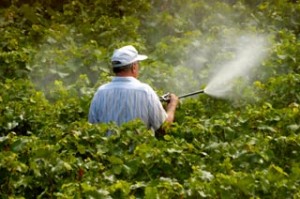Apr 26 2016
Organic Pesticides
 Have you seen the pro-organic propaganda video with the happy family who switches to organic only food and the pesticides disappear from their urine? It has over 5 million hits as of this writing. This is a core fearmongering strategy of the organic lobby.
Have you seen the pro-organic propaganda video with the happy family who switches to organic only food and the pesticides disappear from their urine? It has over 5 million hits as of this writing. This is a core fearmongering strategy of the organic lobby.
Of course, there is no discussion about the absolute level of the pesticides, and the fact that such levels are insignificant and pose no known risk. But there is a deeper deception in this video and many studies looking at the difference in pesticide exposure between conventional and organic produce. They are only testing for pesticides not used by organic farmers. They are not testing for pesticides that are used in organic farming.
The game, therefore, is completely rigged, and the outcome is assured. If they tested only for organic pesticides the results would be flipped.
At this point some readers may be saying to themselves, “But I thought organic farming did not use chemicals,” which, of course, is exactly what the organic lobby wants you to think.
I am writing about this topic now, in fact, because of a recent study looking at the toxicity to bees of leaf fertilizers used in organic farming, showing that:
Two leaf fertilizers—copper sulfate (24% Cu) and a micronutrient mix (Arrank L: 5% S, 5% Zn, 3% Mn, 0.6% Cu, 0.5% B, and 0.06% Mo)—were used in oral and contact exposure bioassays. The biopesticide spinosad and water were used as positive and negative controls, respectively. Copper sulfate compromised the survival of stingless bee workers, particularly with oral exposure, although less than spinosad under contact exposure. Sublethal exposure to both leaf fertilizers at their field rates also caused significant effects in exposed workers.
These are all substances used in organic farming, including the insecticide spinosad used as the positive control. If a similar study were published involving fertilizers used in conventional farming the organic lobby would be all over it, claiming that conventional farming harms bees.
If the happy family were tested for spinosad, their levels would have likely risen after switching to organic food.
Organic Pesticides and Fertilizers
If you read statements about organic farming carefully you will notice they criticize the use of “synthetic” pesticides and fertilizers. (Pesticides is an umbrella term that includes herbicides, insecticides, and fungicides). Use of the term “synthetic” is not gratuitous, because organic farming allows for the use of “natural” pesticides and fertilizers, like the ones used in the above study.
The assumption is that natural pesticides are safer than synthetic pesticides, but there is absolutely no scientific reason for this assumption. The source of a chemical says nothing about the properties of that chemical.
Also, there is a long list of synthetic substances allowed in organic farming, as long as they are deemed “essential.” There are also other criteria about safe use, which are essentially just good practices.
This highlights what I call the false dichotomy of organic farming. They pretend there is a clean divide between organic and conventional, when in fact there are a range of practices with various trade-offs in terms of productivity, cost, sustainability and effects on the environment. I maintain we should use the overall best methods based on scientific evidence, not based upon an ideological dedication to the appeal-to-nature fallacy.
When naturally-derived pesticides are tested, they are just as toxic as many conventional pesticides, especially when you consider the whole picture. You need to consider not just direct toxicity, but how much needs to be used, how often, how much gets into the environment, and the effects on non-target species. Overall the natural pesticides are less effective, and therefore have to be used in large amounts and more frequently.
Here is a list of twelve of the more toxic organic pesticides. They include:
“Pyrethrum is highly toxic to bees. The average lethal dose (LD50) for honeybees was measured at .022 micrograms per bee (Casida & Quistad 1995). Direct hits on honeybees and beneficial wasps are likely to be lethal … Cox (2002) cites several studies indicating the possibility of a connection between pyrethrins and cancer, including one study showing a 3.7-fold increase in leukemia among farmers who had handled pyrethrins compared to those who had not. In 1999, a USEPA memo classified pyrethrins as “likely to be a human carcinogen by the oral route”.
How is this any different than the studies used to fearmonger about relatively nontoxic synthetic pesticides, like glyphosate?
Conclusion
The fact is that the use of pesticides are allowed in organic farming, mostly derived from natural sources but also some synthetic chemical deemed “essential.” There is no apriori reason to assume that chemical pesticides derived from natural sources are safer or better for the environment that synthetic ones.
In fact, by limiting their choices to just some pesticides, they by necessity rely on pesticides that are not as safe or effective as the best synthetic pesticides.
Some organic farmers will argue that they use no pesticides at all, and this is true. However, it is simply not possible to feed the world without the use of some chemical pesticides and fertilizers. We are already using 40% of the Earth’s land, and the most arable land, to grow food. We can’t simply increase this by 25% or so – estimates vary, but they cluster around the conclusion that organic farming is 25% less productive than conventional farming.
I am also not arguing for the overuse or simplistic use of pesticides as an easy solution. The consensus seems to be for integrated pest management. There are also some techniques favored by organic farmers which can help reduce reliance on pesticides. Whatever works is good, but we should follow the evidence, not ideology.






